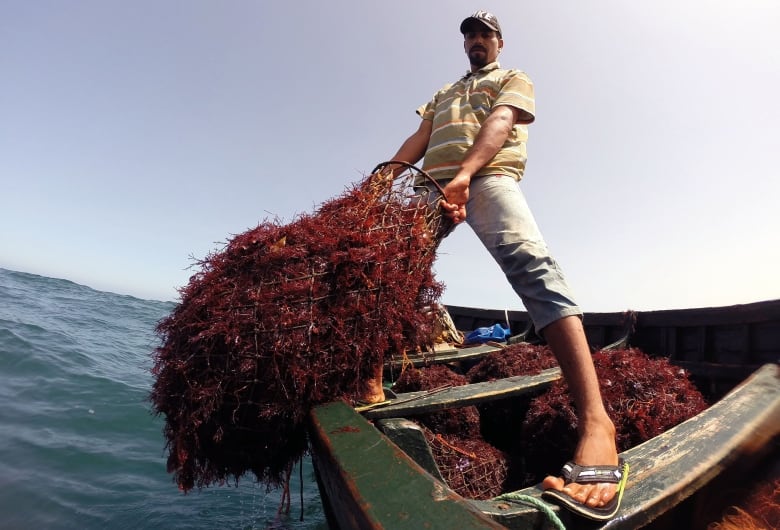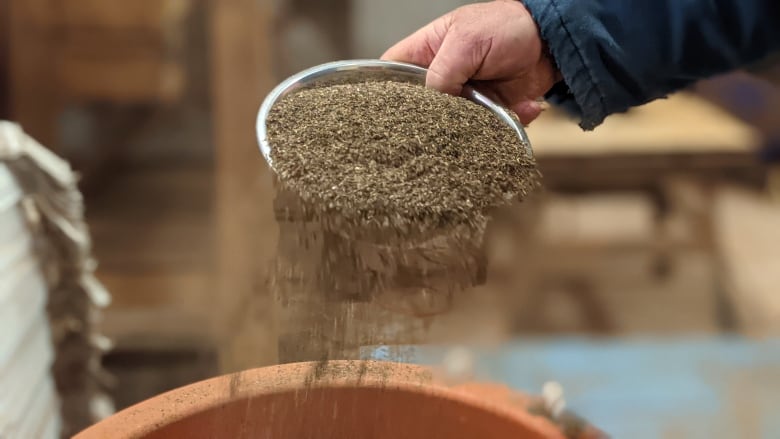How red seaweed might help curb methane emissions from burping cows
Production issues and iodine levels might prevent it from becoming widespread in farming use: scientist

It might surprise you, but burping cows are quite the contributor to climate change.
"If you look globally at enteric methane emissions from livestock, then it's about four or five per cent of the global greenhouse gas emissions," said Karen Beauchemin, a research scientist with Agriculture and Agri-Food Canada.
Enteric emissions, of course, originate from a creature's intestines.
This is why some farmers are starting to feed their cows seaweed, specifically the red, tropical seaweed scientifically known as Asparagopsis taxiformis.
Earlier this year, Australian researchers found that this species of red algae could reduce animal methane emissions "by 32 per cent all the way to 98 per cent, depending on the dose, and the type of animal, and the type of diet," Beauchemin said.
The findings were published in the journal PLOS ONE.
It's a promising prospect, but as Beauchemin tells The Current's Matt Galloway, it's no silver bullet to fighting climate change.
Here's part of their conversation.
How big of an environmental issue are cow burps?
So when the cow eats feed, it digests that feed in its rumen — part of its stomach — and as a by-product of that digestion process, methane is formed. The cow then breathes out and belches out that methane into the atmosphere.
Enteric methane is … also a global problem.-Karen Beauchemin
The Environment and Climate Change Canada produces its national inventory report every year and calculates the methane emissions from ruminant livestock. And in Canada, it's about 3.3 per cent of our national greenhouse gas budget on a carbon dioxide-equivalent basis.
Transportation in Canada, for example, would be 20 per cent of our national greenhouse gas budget. All of agriculture, if you include all the use of fossil fuels in agriculture and everything else growing crops, would be about 10 per cent.
But Matt, enteric methane is … also a global problem.
Are we talking about both beef and dairy cattle?
We're talking about ruminant animals in Canada: beef cattle, dairy animals, and then we have very small populations of sheep and goats.
In Canada, about 90 per cent of the enteric methane emission is from beef, and that's just because of the numbers.
How do you go about measuring how much methane a cow would be giving off?
In a research study when, for example, we're looking at a new feed additive or if we were working on seaweed ... we want to look at that pattern of methane over a few days.
The basic way we would do that is we have these large rooms. So ... we'll place that animal in a room ... and we measure the air coming into the room and the air coming out of the room.
We look at the concentration of methane in the incoming air and open air, and by difference, we know how much methane is produced by the animal.
So … if you feed the cattle seaweed, what does that do in terms of the methane that they would produce?
Asparagopsis taxiformis, that red, tropical seaweed, has a very high concentration of what is called bromoform. That's the chemically active component, and that bromoform blocks the biochemical pathway that is used in the rumen to form methane.

Not all seaweeds contain bromoform, and in fact, most seaweeds we would have in Atlantic waters and Pacific waters do not contain bromoform. So we're interested in other components.
So we've identified phlorotannins ... another component in seaweed that also can interfere with that biochemical synthesis of methane.
Given the scale of the problem, is there enough seaweed out there that can be farmed at a sustainable level to address this issue?
The answer to that is absolutely no.
In terms of Asparagopsis taxiformis ... the idea would be not to harvest that directly from native waters, but rather to produce it in tanks locally near the source. There's a lot of issues before we see something like that on the market for farmers.

We also want to know what other impacts bromoform has. Bromoform has been identified by the [United States Environmental Protection Agency]. It's a potentially carcinogenic compound, so we want to be absolutely sure there's no residues in meat and milk, for example.
It also has high iodine levels, so when you put that in an animal's diet, that increases the iodine concentration of meat [and] milk. Not that it would be anywhere close to exceeding the maximum recommended amount, but that definitely needs to be checked out.
[If] you produce seaweed in tanks to ship across the country, you'd need to dry it down, so then there's emissions associated with transportation.
There's a lot of production issues that would need to be worked out before seaweed itself becomes a widespread mitigation tool.
Written by Mouhamad Rachini. Produced by Mary-Catherine McIntosh. Q&A edited for length and clarity.
